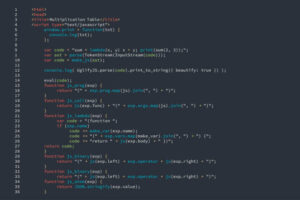Testing is essential during the software development process. This Javascript Beginners Guide with Cypress, is a critical part of software testing development that must be well-examined, studied, and implemented with the right tools.
Over the years, different testing tools have been rolled to developers and while some have been able to stand the test of time, some have failed to keep up with the latest architecture.
Javascript as a programming language has become one of the most adored and its essential platforms built on this language are well tested. To ensure smooth testing, Cypress was introduced to help Javascript developers navigate through the difficulties that come with testing.
This article will give a precise detail on everything that needs to be known about Cypress.
What is Cypress
Cypress is a JavaScript-based end-to-end testing framework that empowers developers to write and execute tests directly in the browser. Cypress enables us to perform various types of tests, ranging from integration tests to API tests.
This developer-friendly tool operates directly in the browser using a DOM manipulation technique and enables front-end developers and QA engineers to write automated web tests while eliminating pain points.
Undoubtedly one of the best testing frameworks, Cypress offers developers various benefits. Below are reasons why you should opt for Cypress.
Benefits of Using Cypress Testing
Cypress Is More Universal
When compared to other automation frameworks, Cypress is more universal because it is written in JavaScript and based on Mocha and Chai. It also uses Node.js when running in browsers.
Simple to Set Up
It is easy to get started with Cypress automation for web testing. Some testing framework requires selecting all the dependencies and libraries that you need before you start testing. However, with Cypress, these dependencies and libraries are already set in place with no configuration needed.
User Friendly
Since Cypress tests are created in a language that is already familiar to developers, it makes the tool that much more user-friendly. With Cypress, you can also run cross-browser testing. You can execute tests with Cypress on Firefox and browsers within the Chrome family, such as Edge and Electron.
Cypress Has Debugging Capabilities
You can debug your web apps with Cypress quickly and easily. When tests fail, you get suggestions for how to fix the defect. From there, you can debug directly from Chrome DevTools. Cypress also supports capabilities like Time Travel and real-time reload.
This ensure that developers can examine their website code both during and after a test execution.
Cross Browser Testing
Cypress JavaScript supports cross-browser testing and can run tests on different browsers. This makes it easy to ensure that your application works as expected across different browsers.
Offers Fast Test Execution
Cypress is known for its fast test execution — with a response time of less than 20, MS. Cypress has automatic waiting built into the framework, which means that you do not need to define implicit and explicit waits.
Automatic Screenshots and Videos
Cypress JavaScript can automatically take screenshots and record videos of your tests, making it easy to see what happened during a test run. This can be helpful when trying to identify issues or bugs in your application.
Active Community
Cypress is a free and open-source framework. It has been adopted across the globe and it boasts an active community on GitHub, Gitter, and StackOverflow. Plus, Cypress offers robust documentation.
Types of testing performed using Cypress JavaScript
With Cypress, you are allowed to perform various tests. Here are tests you can perform and how to go about it.
User Interface (UI) Testing
Cypress allows easy and comprehensive UI testing. Cypress provides APIs that allow developers and testers to interact with the web application’s UI elements and simulate user interactions while performing Cypress UI automation.
It also provides an automatic waiting mechanism that waits for the UI to finish rendering, ensuring that the tests are accurate, reliable, and less flaky.
Component Testing
Cypress is also suitable for component testing, which is useful when working with a modular application that utilizes several components. This testing approach helps to identify and resolve issues early in the development process, reducing the chances of the web application crashing.
Mobile Responsiveness Testing
Cypress can be used for web application responsive testing across different viewports. Cypress provides a viewport resizing feature, allowing testers to simulate mobile devices’ different screen sizes, making it easy to test the web application’s responsiveness.
You can also integrate Cypress JavaScript with third-party mobile testing platforms like LambdaTest, which offer access to a vast range of mobile devices and operating systems.
Accessibility Testing
Cypress can be used to test the accessibility of the web application. Cypress JavaScript provides an integrated accessibility testing library called cypress-axe, which uses the Axe engine to detect accessibility issues and generate accessibility violation reports.

Application Programming Interface (API) Testing
Cypress can also be used to test the web application’s APIs. Testers can use Cypress to send HTTP requests and validate the responses.
With a built-in command called cy.request() that enables testers to send HTTP requests, you can make assertions based on the received responses while performing Cypress API testing.
Cypress JavaScript also supports response interception, mocking, and stubbing, allowing testers to simulate different server responses.
End-to-end (E2E) testing
End-to-end (E2E) testing is a software testing methodology that verifies the working order of a software product in a start-to-finish process. It ensures that all components of a system can run under real-world scenarios.
How to Install Cypress
Installing cypress is easy as writing your first “Hello word” code. To install Cypress, you will require the latest version on node js. Follow the steps below to install Cypress.
- Install Node.js
Cypress requires Node.js to be installed on your system. You can download and install the latest version of Node.js from the official website https://nodejs.org.
- Create a new project
Create a new directory for your Cypress project and navigate into it using the command line. Run npm init to create a package.json file.
- Install Cypress
Install Cypress by running the following command in the command line.
npm install cypress –save-dev or yarn add cypress –dev
NOTE: –save-dev is a command-line option used with Node Package Manager (npm) to install and save development dependencies for a project.
Once installed, you can open Cypress by running the following command in the command line.
yarn run cypress open
Cypress Commands
Cypress commands provide you with the option to create custom functionality and even replace preexisting commands. Making a custom command is typically a smart idea when you start to truly understand that you are repeatedly writing the same functionality across several tests, or repeating yourself.
This command could take the form of a click, website navigation, or even finding an element. Frequently used command in cypress is known as ‘get’.
cy.get(‘selector’): This command returns an element based on the selector it uses. In order to locate the components to interact with, you would execute this command.
Frequently used keywords in Cypress
The following are some of the key constructs frequently used in Cypress test development.
describe()
This method is used to group related test cases. It takes two arguments: a string that describes the group of test cases and a callback function that contains the individual test cases.
it()
This method is used to define a test case. It takes two arguments: a string that describes the test case and a callback function that contains the actual test code
before()
This method is used to run a setup function before any test case in a particularly described block. It can be used to set up the test environment, initialize variables, and perform other setup tasks.
after()
This method is used to run a cleanup function after all the test cases in a particularly described block have finished running. It can be used to clean up the test environment, close open connections, and perform other cleanup tasks.
beforeEach()
This method is used to run a setup function before each test case in a particularly described block. It can be used to reset the state of the test environment and perform other setup tasks.
afterEach()
This method is used to run a cleanup function after each test case in a particularly described block has finished running. It can be used to reset the state of the test environment and perform other cleanup tasks.
skip()
When dealing with a large codebase and wanting to concentrate on specific tests or subsets of tests, the .skip() function provides a handy means to temporarily prevent certain tests from being executed.
Conclusion
Cypress ensures you build a platform that stands the test of time and fulfills its purpose. It is an open-source JavaScript testing tool designed to make testing web applications fast, easy, and reliable. This testing platform allows developers to write automated tests that simulate user interactions and verify the behavior of the applications.
Easy to install and set up, Cypress can be used to perform various testing. This includes User Interface (UI) Testing, component testing, mobile responsiveness testing and lots more. With its supportive community, beginners will have no issues navigating through the concept of cypress.





